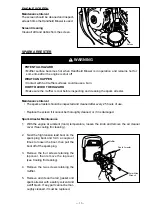
— 9 —
BEFORE OPERATION
FUELING
WARNING! The following precautions will lessen the risk of fire.
1.
Do not smoke near fuel.
2.
Mix and pour fuel outdoors and where there are no sparks or flames.
3.
Always shut off the engine before refueling. Never remove the fuel tank cap while the engine is
running or immediately after stopping the engine.
4.
Always open the fuel tank cap slowly to release any possible pressure inside the tank.
5.
Do not overfill the fuel tank. Stop filling 6 ~ 13 mm (1/4 ~ 1/2 inch) from the top of the tank.
6.
Tighten the tank fuel cap carefully but firmly after refilling.
7.
Wipe up any spilled fuel before starting the engine.
8.
Move the Handheld Blower at least 3 m (10ft.) away from the fueling location and fuel storage
container before starting the engine.
WARNING
POTENTIAL HAZARD
• Gasoline contains gasses that can build up pressure inside a gas tank.
WHAT CAN HAPPEN
• Fuel can be sprayed on you when removing fuel tank cap.
HOW TO AVOID THE HAZARD
• Remove fuel tank cap slowly to avoid injury from fuel spray.
DANGER
POTENTIAL HAZARD
• In certain conditions gasoline is extremely flammable and highly explosive.
WHAT CAN HAPPEN
• A fire or explosion from gasoline can burn you, others, and cause property damage.
HOW TO AVOID THE HAZARD
• Use a funnel and fill the fuel tank outdoors, in an open area, when the engine is cold.
Wipe up any gasoline that spills.
• Do not fill the fuel tank completely full. Add gasoline to the fuel tank until the level is 6 ~
13mm (1/4 ~ 1/2 inch) below the bottom of the filler neck. This empty space in the tank
allows gasoline to expand.
• Never smoke when handling gasoline, and stay away from an open flame or where gaso-
line fumes may be ignited by a spark.
• Store gasoline in an approved container and keep it out of the reach of children.
• Never buy more than a 30-day supply of gasoline.







































